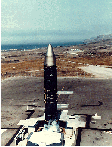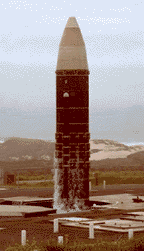LGM-118A Peacekeeper ICBM
Left to Right: Technicians inspect an MX PBV; Technicians inspect an MX PBV; A "cold launch" of an MX
in 1987 from a modified LGM-30G Minuteman III (MM III) ICBM silo (US Government/ US DoD Photos); Another shot of an LGM-118 launch (USAF photo); Yet another Peacekeeper launch (USAF photo)
LGM-118A Specifications
| Origin: | Boeing Aerospace USA
|
| Launch Weight: | 195,015 lbs
|
| Length: | 70.8ft
|
| Diameter: | 7ft 8in
|
| Guidance: | High-precision inertial; integrated by Rockwell
|
| Speed: | Aprroximately 15,000mph (Mach 23) at burnout
|
| Range: | 6,900+mi
|
| Ceiling: | 700mi
|
| Warheads: | 10 W87 300-KT warheads in Avco MK 21 MIRVs
|
| Unit Cost: | $70 Million US
|
| Total Force: | 50 Active Force; AFRES 0; ANG 0
|
BACKGROUND
The LGM-118 Peacekeeper ICBM was first launched
on 17 June 1983. The Peacekeeper, formerly known as the MX (Missile Experimental) was designed
to supercede the Minuteman and Titan ICBMs and is a vast improvement in terms of range, payload,
and most important of all, accuracy.
The LGM-118 consists of 3 stages: the boost system, Post-Boost Vehicle (PBV), and the Re-entry System. The boost system
is divided into 3 rocket stages using solid HTBP propellant and single movable nozzles.
The PBV, mounted on top of the boost vehicle, is about 4 ft long, and weighs in at roughly
3,000 pounds. It maneuvers the missile using several small rockets using hypergolic liquid propellants, in order to deploy each of the 300-kiloton
Re-entry Vehicles, or RVs, to their respective targets. The Peacekeeper's warheads are amazingly accurate:
one USAF officer was quoted as saying that the Peacekeeper's accuracy was "absolutely eye-watering" (meaning it was so good it would bring a tear to your eye). Some reports have credited the Peacekeeper's MIRVs with a CEP of under 150ft (50m).
This phenomenal accuracy allows the LGM-118 to attack "counterforce" targets, such as supercritical Command&Control (C&C) installations and possibly even individual superhardened missile silos.
The ten MK-21 RVs, each one housing a 300-KT W87 warhead, are deployed after the missile's nose shroud has been released, allowing the RVs to be unlatched one by one using gas pressure
from explosive cartridges broken by explosive bolts.
The LGM-118's lauch center is hardened for a near-miss by a 15 KT warhead. The launch is controlled by 2 officers who insert their launch keys several feet apart (to prevent 1 person
from launching the missile), and turn their keys simultaneously 1/4 of a turn, and hold it for several seconds. The launch is controlled by a Hewlett-Packard LC5400 computer, sheathed in
Titanium.
The U.S. Air Force achieved Inital Operational Capability (IOC) with the Peacekeeper ICBM in December 1986 at Warren AFB with in initial squadron of
10 missiles, and achieved full operational capability in December 1988 with a full squadron of 50 missiles. Originally, a force of 114 missiles had been planned, but funding for
this number was limited to only 50 missiles in the FY 1990 Budget.
Recently the U.S. has agreed to eliminate all its multiple-rentry vehicle Peacekeepers by the year 2003 as a part of the Strategic Arms Reduction Treaty II, or START II.
However, this treaty has been ratified by the U.S. Senate, but not the Russian Duma, and until it is, no retirement will occur.



